
The Complete Guide to Comparing Laboratory Sink Cabinets
The Complete Guide to Laboratory Sink Cabinets
A laboratory sink cabinet is a specialized storage unit designed to house sinks in laboratory environments while providing storage space for supplies and equipment. These cabinets are essential components of any functional lab setup, offering:
| Key Features of Laboratory Sink Cabinets | Why They Matter |
|---|---|
| Chemical-resistant construction | Protects against spills and corrosion |
| Standard heights: 35" (bench) or 29-30" (desk) | Ensures ergonomic workflow |
| Common widths: 12" to 60" | Accommodates various lab layouts |
| Specialized sink materials (epoxy resin, stainless steel) | Provides durability in harsh environments |
| Modular design | Allows for customization and reconfiguration |
| Safety features (acid storage, containment) | Ensures compliance with lab regulations |
Laboratory sink cabinets serve as critical workstations where researchers, technicians, and students perform wet processes, handle chemicals, and maintain cleanliness in the lab environment. Unlike residential cabinetry, these specialized units are built to withstand the rigorous demands of scientific work, featuring chemical-resistant materials, robust construction, and designs that comply with safety standards like SEFA 8 and OSHA regulations.
Selecting the right laboratory sink cabinet involves careful consideration of material composition, size requirements, sink type, and safety features to ensure seamless integration with your lab's workflow and compliance needs. Whether you're designing a new lab or upgrading existing facilities, understanding the nuances of these specialized cabinets will help you make informed decisions that improve productivity, safety, and longevity.
I'm Mortuary Cooler, with extensive experience designing specialized laboratory environments including customized laboratory sink cabinet solutions for forensic, medical, and research facilities. My background in laboratory equipment integration has provided knowledge of how proper sink cabinet selection impacts workflow efficiency and safety compliance.
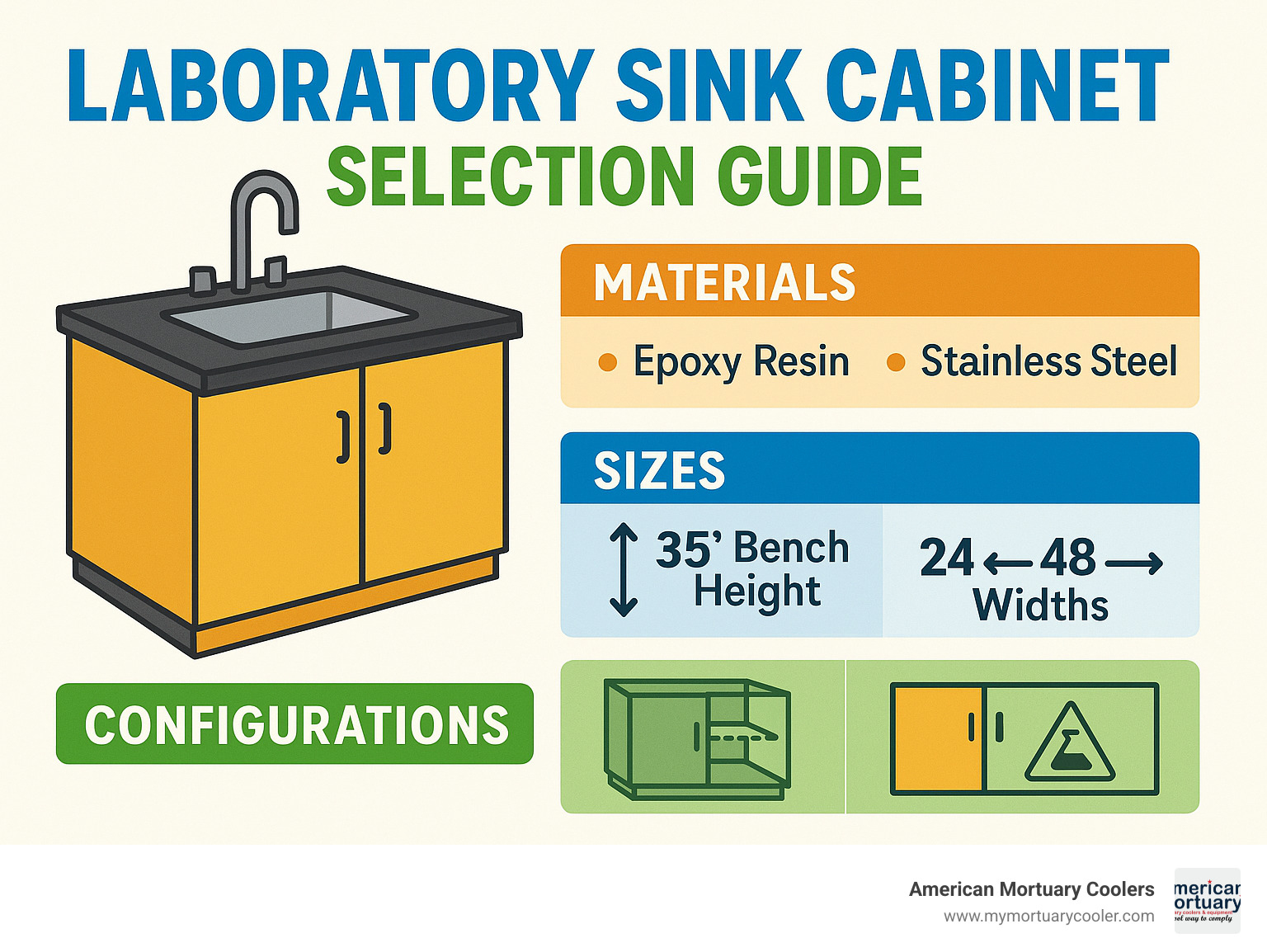
Laboratory sink cabinet word roundup:
Why Your Lab Needs a Purpose-Built Sink Cabinet
When it comes to laboratory operations, wet processes are inevitable. From washing glassware to disposing of liquid waste, these activities require a dedicated space that can safely contain spills and manage water. A purpose-built laboratory sink cabinet serves as the central hub for these wet processes, offering:
- Spill containment: Laboratory sink cabinets often feature coved corners and raised lips to prevent liquids from escaping the work area
- Integrated storage: Unlike standard cabinets, lab sink units are designed to accommodate plumbing while still providing valuable storage space for cleaning supplies and equipment
- Chemical resistance: Purpose-built cabinets use materials specifically chosen to withstand exposure to acids, bases, solvents, and other laboratory chemicals
- Proper waste management: Many lab sink cabinets incorporate neutralization tanks or specialized plumbing for safe disposal of laboratory waste
In our experience working with research facilities across the country, from our Atlanta location to our Los Angeles branch, we've found that labs without proper sink cabinets often struggle with workflow inefficiencies and safety concerns. A dedicated laboratory sink cabinet isn't just a convenience—it's a necessity for maintaining a safe, efficient, and compliant laboratory environment.
What Is a Laboratory Sink Cabinet?
A laboratory sink cabinet is the unsung hero of every well-designed lab – a specialized piece of casework that does much more than just hold a sink. Think of it as command central for all your wet work, carefully engineered to handle the demands of scientific environments.
These cabinets serve as dedicated stations where researchers wash glassware, dispose of liquids, and manage the inevitable splashes and spills that come with laboratory work. Beyond just housing a sink, they provide crucial storage space for cleaning supplies while cleverly concealing all the necessary plumbing connections.

When shopping for a laboratory sink cabinet, you'll typically find two height options to choose from. Bench height cabinets stand 35" tall, designed to align perfectly with your other lab benchtops for a seamless work surface. If you'll be doing seated work, desk height cabinets at 29-30" tall provide comfortable access for those longer sessions.
Most laboratory sink cabinets maintain a standard depth of about 22" – deep enough to accommodate plumbing while still keeping everything within comfortable reach. Width options typically range from slim 12" models to expansive 60" versions, with 30", 36", and 48" widths being the most popular choices for most labs.
What truly sets these cabinets apart is their robust construction. Unlike ordinary cabinetry, a proper laboratory sink cabinet features welded 18-gauge steel construction with chemical-resistant powder coating. They're built with modular designs that integrate seamlessly with other lab furniture, reinforced bases to support heavy sinks, and thoughtful access panels that make plumbing maintenance a breeze.
Laboratory Sink Cabinet vs. Kitchen & Bathroom Cabinets
It might be tempting to save money by repurposing residential cabinetry, but this is one area where cutting corners can be costly. Laboratory sink cabinets differ from kitchen and bathroom cabinets in critical ways that affect both safety and longevity.
While your home cabinets might be made from particleboard with decorative laminate, lab cabinets feature industrial-grade steel with specialized chemical-resistant finishes. A laboratory sink cabinet is built to SEFA 8 standards, typically supporting 500+ pounds – more than double what residential cabinets can handle.
The construction methods differ too. Lab cabinets are fully welded with reinforced bases, not just assembled with screws and glue. They're designed with easy access to plumbing connections and often include specialized safety features like acid storage compartments or containment trays.
In our years of experience at American Mortuary Coolers, we've seen what happens when labs try to cut corners with residential-grade cabinets – they simply don't last in demanding scientific environments. The chemicals eat through the finishes, the weight compromises the structure, and before long, you're facing replacement costs far exceeding what you "saved" initially.
Standard Sizes & Configurations of a Laboratory Sink Cabinet
Laboratory sink cabinets come in a variety of configurations to suit different spaces and workflows. The width options typically follow standard increments: 12", 18", 24", 30", 36", 48", and 60".
The configuration you choose depends largely on your space and storage needs. Single door models work well for narrower cabinets (12"-24"), while double door designs make sense for wider units (30"-60"). Many labs prefer door/drawer combinations that offer more organized storage options, with drawers conveniently positioned above cabinet doors.
For larger labs, specialized configurations like island units (accessible from both sides) or peninsula units (accessible from three sides) can maximize workflow efficiency.
One of the best features of quality laboratory sink cabinets is their modularity. Most manufacturers design their cabinets to work as part of a system, allowing you to create custom configurations that perfectly fit your space. This extends to the cabinet components themselves – look for models with adjustable shelving, reversible doors, and interchangeable drawer configurations that can adapt as your needs change.
From our work with laboratories across the country, we've found that 36" and 48" wide cabinets with double doors hit the sweet spot for most facilities – providing generous sink space while maintaining ample storage below. Whatever size you choose, investing in proper laboratory-grade construction will pay dividends in durability and safety for years to come.
Materials, Sink Types & Configurations
Choosing the right materials for your laboratory sink cabinet can make or break your lab's efficiency and safety. After all, these workstations face chemical spills, heavy use, and constant moisture—not exactly a friendly environment for standard cabinetry!
Cabinet Materials: Most labs rely on welded steel cabinets with chemical-resistant powder coating—they're the workhorses of the lab world. For environments where corrosion is a constant concern, stainless steel cabinets offer superior protection, though at a higher price point. Polypropylene cabinets excel in highly corrosive settings, while wood cabinets with chemical-resistant laminate provide a more budget-friendly option for educational settings where extreme chemical exposure is less common.
When it comes to the sink itself, you've got several reliable options. Epoxy resin sinks have become the gold standard in chemical labs thanks to their seamless construction and exceptional resistance to just about anything you might pour down them. Stainless steel sinks (typically 304 grade) offer excellent heat resistance and are easier on the budget while still providing good chemical resistance for general lab use. Polypropylene sinks give you great chemical protection at a lower price point, though they don't handle heat well. Phenolic resin offers a nice middle ground with good all-around performance and color options.
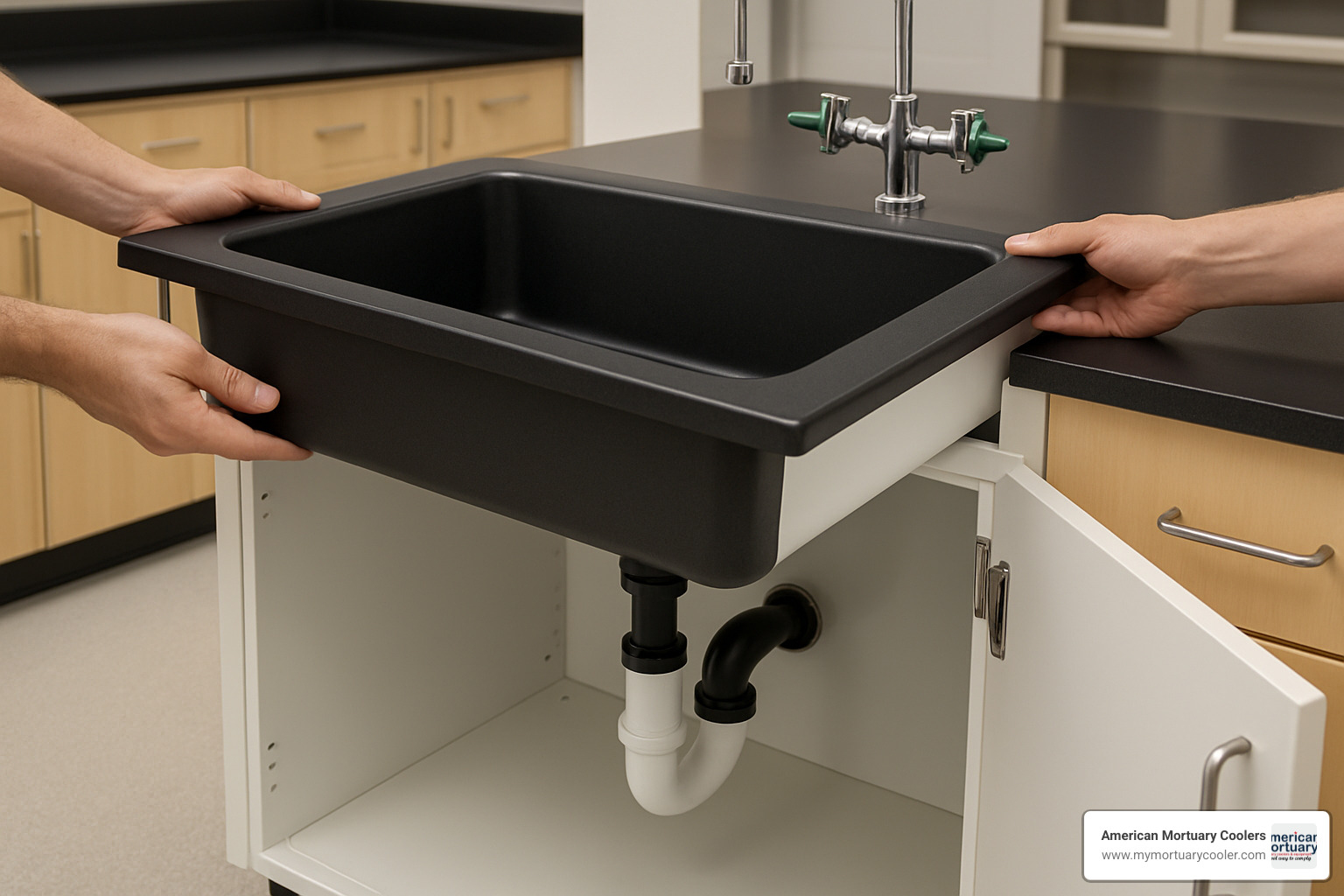
Let's compare these sink materials side by side:
| Sink Material | Chemical Resistance | Heat Resistance | Durability | Cost | Best For |
|---|---|---|---|---|---|
| Epoxy Resin | Excellent | Good (up to 300°F) | Excellent | High | Chemical labs |
| Stainless Steel | Good | Excellent (up to 800°F) | Excellent | Medium-High | General purpose, teaching labs |
| Polypropylene | Excellent | Poor (up to 180°F) | Good | Low-Medium | Acid work, budget constraints |
| Phenolic Resin | Very Good | Good (up to 350°F) | Very Good | Medium | Teaching labs, general purpose |
When it comes to installation, you'll typically choose between drop-in sinks (which sit on top of the countertop with a visible lip), undermount sinks (attached from below for a seamless look), or integral sinks that are formed as one piece with the countertop (common with epoxy resin).
Height matters too! Laboratory sink cabinets come in bench height (35") for standing work and desk height (29-30") for seated work or ADA compliance. We've found that the right height choice dramatically affects user comfort during those long days of sample processing or glassware cleaning.
For labs with specialized needs, don't forget to consider add-ons like acid-resistant liners with coved corners that make cleanup a breeze, containment trays to catch those inevitable spills, or pegboards mounted above the sink for drying glassware. Many labs also benefit from cupsinks—those small auxiliary sinks that provide convenient disposal points around the lab.
In our years of equipping specialized facilities across the country, we've noticed that epoxy resin sinks housed in stainless steel cabinets provide the sweet spot of durability and chemical resistance for most research and testing laboratories.
Popular Sink Inserts: Pros & Cons
Choosing the right sink for your laboratory sink cabinet isn't just about price—it's about matching your lab's specific needs with the right material. Let's break down your options:
Epoxy Resin Sinks are the heavyweight champions of chemical resistance. These dark workhorses (typically black) handle acids, bases, and solvents without breaking a sweat. Their seamless construction means no leaks, and the non-porous surface won't harbor bacteria. Many come with built-in drain troughs and a quarter-inch lip to contain spills—features you'll appreciate during that inevitable "oops" moment with a flask of something nasty.
The downside? They're not exactly budget-friendly, and despite their toughness against chemicals, they can crack if you drop something heavy enough. Installation requires some expertise, and your color options are basically "any color as long as it's black."
Stainless Steel Sinks shine (literally) in versatility. They shrug off heat damage, clean up beautifully, and maintain their professional appearance for years. They're more affordable than epoxy and available in countless configurations. We've installed these in everything from high school labs to sophisticated research facilities with great results.
Just keep in mind that strong acids are their kryptonite, and they'll show water spots unless regularly wiped down. They can dent under impact, and those seams can eventually become weak points if not properly maintained.
Polypropylene Sinks are the budget-friendly option that doesn't skimp on chemical resistance. Lightweight and available in different colors, they're particularly good with acids. Installation is straightforward, making them popular for lab renovations on tight budgets.
The tradeoff comes in heat resistance—anything above 180°F can cause problems. They scratch more easily than other options and may become brittle after years of chemical exposure. Think of them as the economical option that gets the job done without the bells and whistles.
In our experience outfitting labs across the country, we've found that general-purpose laboratories typically get the best value from stainless steel, while specialized chemical labs benefit tremendously from investing in epoxy resin. Your choice should always be guided by the specific chemicals and processes your team uses daily.
Configuring Your Laboratory Sink Cabinet for Specialized Tasks
Your laboratory sink cabinet can do so much more than just provide a place to wash glassware. With the right configuration, it becomes a specialized workstation custom to your lab's unique needs.
Neutralization tanks are lifesavers for labs that regularly work with acids. These clever systems use limestone to neutralize acidic waste before it hits your building's plumbing system—potentially saving you from costly pipe replacements and environmental fines. Available in 5-gallon models for lighter use or 15-gallon tanks for busy labs, they tuck neatly beneath your sink cabinet. Trust us, your facilities manager will thank you for this investment!
Need ultra-pure water at your sink? DI water faucets deliver deionized or distilled water through non-reactive materials like polypropylene or PVC. They're typically color-coded (look for green or blue handles) and use dedicated supply lines to prevent contamination. We've seen these transform workflow efficiency in analytical labs where water purity is critical.
For labs where cross-contamination is a concern, foot pedal controls are worth their weight in gold. Beyond reducing contamination, they make multitasking easier, conserve water, and reduce repetitive motion injuries. Some sophisticated models even integrate with mixing faucets so you can control temperature hands-free—a feature particularly appreciated in microbiology and clinical settings.
Don't overlook cupsinks—those small 3-6" diameter auxiliary sinks that might seem insignificant but prove incredibly useful. They provide quick disposal points for small liquid volumes, connection points for aspirator vacuum systems, and secondary containment for hazardous material handling. They can be integrated into countertops away from the main sink, creating multiple waste disposal points throughout your lab.
For specialized needs, consider these configurations:
- ADA-compliant sinks feature a 5" depth to meet knee clearance requirements
- Corner drain sinks maximize usable space inside the basin
- Multiple basin sinks allow separation of different processes
- Overflow prevention systems integrate additional outlets to prevent flooding
After outfitting hundreds of specialized research facilities, we've learned that the thoughtful configuration of laboratory sink cabinets with appropriate accessories significantly improves both safety and efficiency. The modest additional investment in specialized features typically pays for itself many times over in improved productivity and reduced risk.
Safety Features, Compliance & Workflow Optimization
Let's talk about safety - it's not just a checkbox, it's the foundation of a well-designed lab. Your laboratory sink cabinet plays a starring role in keeping everyone safe while they work.
Modern lab sink cabinets come packed with thoughtful safety features that do more than just look good on an inspection report. They actively protect your team every single day.
For storing those tricky acids, today's laboratory sink cabinets offer smart solutions like one-piece composite liners with smooth coved corners (no sharp edges or seams where chemicals can hide). Many include removable containment trays that make cleanup a breeze when the inevitable spill happens. You'll also find corrosion-resistant hardware that won't fail when exposed to harsh chemicals, and venting options that prevent dangerous vapor buildup. These acid-storage cabinets come in various sizes from compact 12" models to spacious 48" versions to fit your specific needs.
Need to store flammables near your sink area? Look for cabinets with liquid-tight pans to contain any leaks, self-closing doors with secure three-point latching, and fire-resistant construction that meets NFPA 30 standards. Don't forget about grounding connections to prevent static discharge (particularly important around flammable materials) and clear, prominent labeling so everyone knows exactly what's inside.
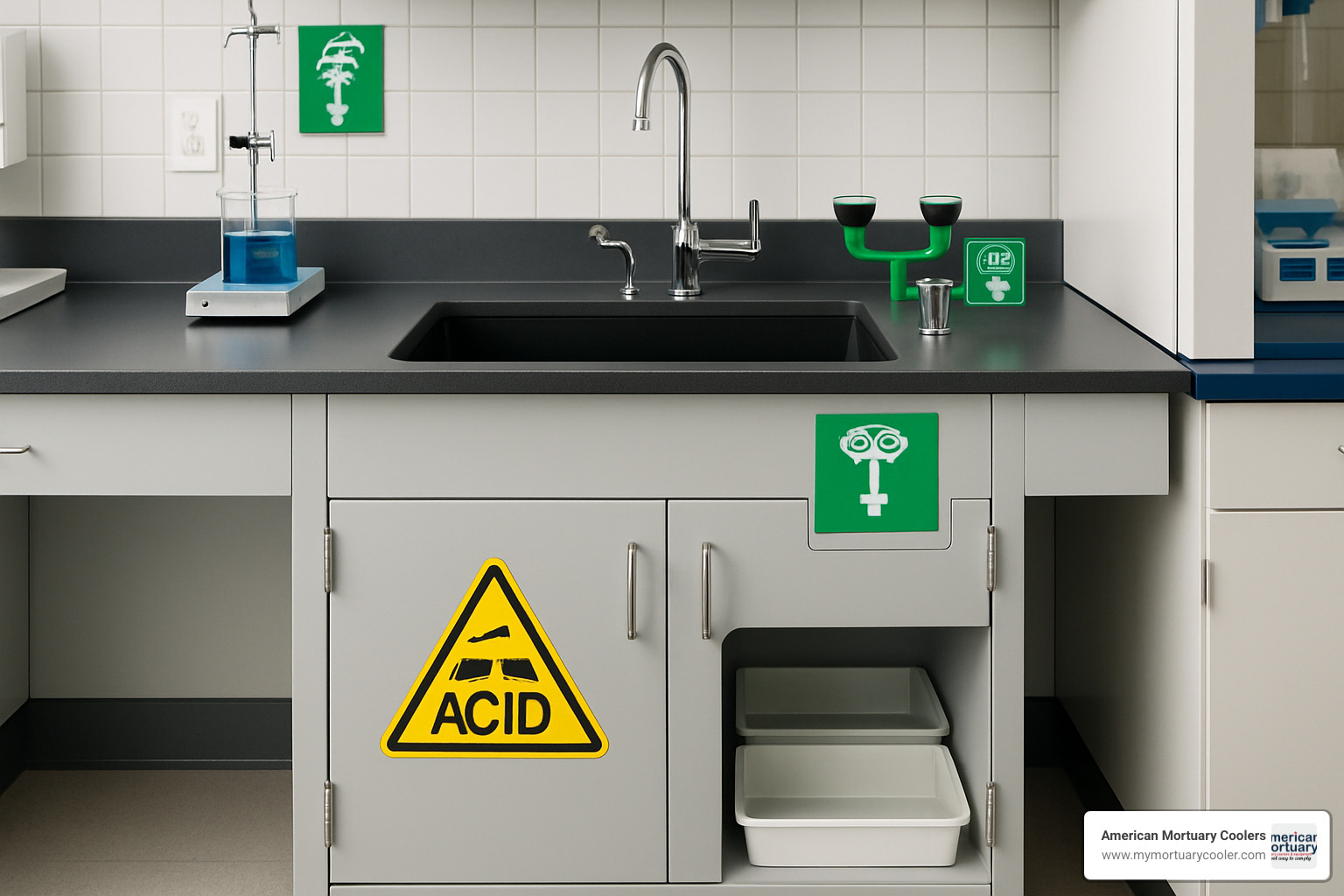
Many laboratory sink cabinets can be integrated with crucial safety equipment like eyewash stations mounted directly on or adjacent to the cabinet, emergency shower connections, first aid storage, spill containment kits, and clear safety signage. This integration means help is right where you need it when seconds count.
When it comes to compliance, your laboratory sink cabinet needs to meet several important standards:
- SEFA 8 guidelines establish durability and performance benchmarks
- OSHA 1910.106 regulates how flammable and combustible liquids should be stored
- ANSI Z358.1 sets requirements for emergency eyewash and shower equipment
- NFPA 30 provides the Flammable and Combustible Liquids Code
- UL 1805 certifies chemical resistance in laboratory furniture
Working with sensitive electronics? Don't overlook ESD (Electrostatic Discharge) considerations. Your sink cabinet should include proper grounding connections, conductive work surfaces, and a continuous path to ground from all metal components.
In our years of experience working with labs across the country, we've consistently seen that facilities that build comprehensive safety features into their laboratory sink cabinets have fewer accidents and sail through compliance inspections with flying colors.
Laboratory Sink Cabinet Placement for Maximum Safety
Where you put your laboratory sink cabinet matters just as much as what features it has. Smart placement improves both safety and workflow.
Think about traffic flow first. Position sink cabinets away from busy walkways to reduce the chance of collisions (especially important when someone's carrying chemicals). Make sure there's always clear access during emergencies, and provide enough space for multiple people to use the area when needed.
Emergency access is non-negotiable. Maintain unobstructed paths to emergency exits, position eyewash stations within a 10-second walk from hazard areas, and ensure safety equipment is visible from all work areas.
Plan your utilities routing thoughtfully. Efficient plumbing connections minimize trip hazards, and you'll want to think ahead about maintenance access. Keep electrical outlets at safe distances from water sources, and include provisions for specialized gas or vacuum lines if your work requires them.
Some tried-and-true placement wisdom we've gathered: locate sink cabinets near laboratory entrances so people can wash hands when entering and leaving, keep acid storage cabinets away from incompatible materials, ensure plenty of good lighting above sink areas, install slip-resistant flooring where water might splash, and consider sight lines for supervision in teaching environments.
We've designed countless lab spaces over the years, and we've seen how thoughtful placement of laboratory sink cabinets not only makes labs safer but also more efficient by reducing unnecessary movement and creating logical work zones.
Verification & Testing to Meet SEFA 8 and Beyond
That shiny new laboratory sink cabinet might look great, but how do you know it's up to the task? Rigorous testing and verification are essential.
SEFA 8 standards specify exactly how much weight your cabinets should handle. Cabinet bottoms should support 200 pounds per square foot, while shelves need to hold 100 pounds per square foot. Drawer bodies should carry at least 75 pounds, and doors must support 200 pounds when fully open. These aren't just arbitrary numbers – they reflect the real-world demands of busy lab environments.
Chemical resistance testing is equally important. The SEFA 8 chemical spot tests evaluate how well surfaces stand up to acids like sulfuric, nitric, and hydrochloric; bases such as sodium hydroxide and ammonium hydroxide; solvents including acetone, ethyl acetate, and toluene; and various biological stains and indicators.
Once installed, field verification ensures everything works as intended. This includes plumbing leak testing, checking door and drawer alignment, verifying that all safety features function properly, and confirming accessibility compliance measurements.
Don't forget about documentation – you'll need the manufacturer's certification of SEFA 8 compliance, Material Safety Data Sheets for all cabinet components, installation verification reports, and maintenance and cleaning protocols.
Through our extensive work with specialized laboratory environments across the country, we've found that thorough verification and documentation of laboratory sink cabinet compliance doesn't just tick regulatory boxes – it also makes future maintenance decisions much simpler and helps ensure your investment lasts for years to come.
Selecting, Installing & Maintaining Your Laboratory Sink Cabinet
Selecting the right laboratory sink cabinet involves balancing several factors including budget, functionality, and specific laboratory requirements:
Budget Considerations:
- Basic laboratory sink cabinets start around $1,400
- Mid-range options with additional features: $2,500-$5,000
- High-end custom configurations can reach $16,000 or more
- Factor in installation costs (typically 15-25% of cabinet cost)
- Consider lifetime cost including maintenance and durability
Lead Times:
- Stock cabinets: 2-3 weeks
- Custom configurations: 6-8 weeks
- Allow additional time for shipping to remote locations
- Plan for potential pandemic-related delays (currently 20-25 production days typical)
Customization Options:
- Color choices (white most common, but many options available)
- Size modifications for specific space requirements
- ADA compliance features for accessibility
- Custom countertop and sink material combinations
- Specialized storage configurations
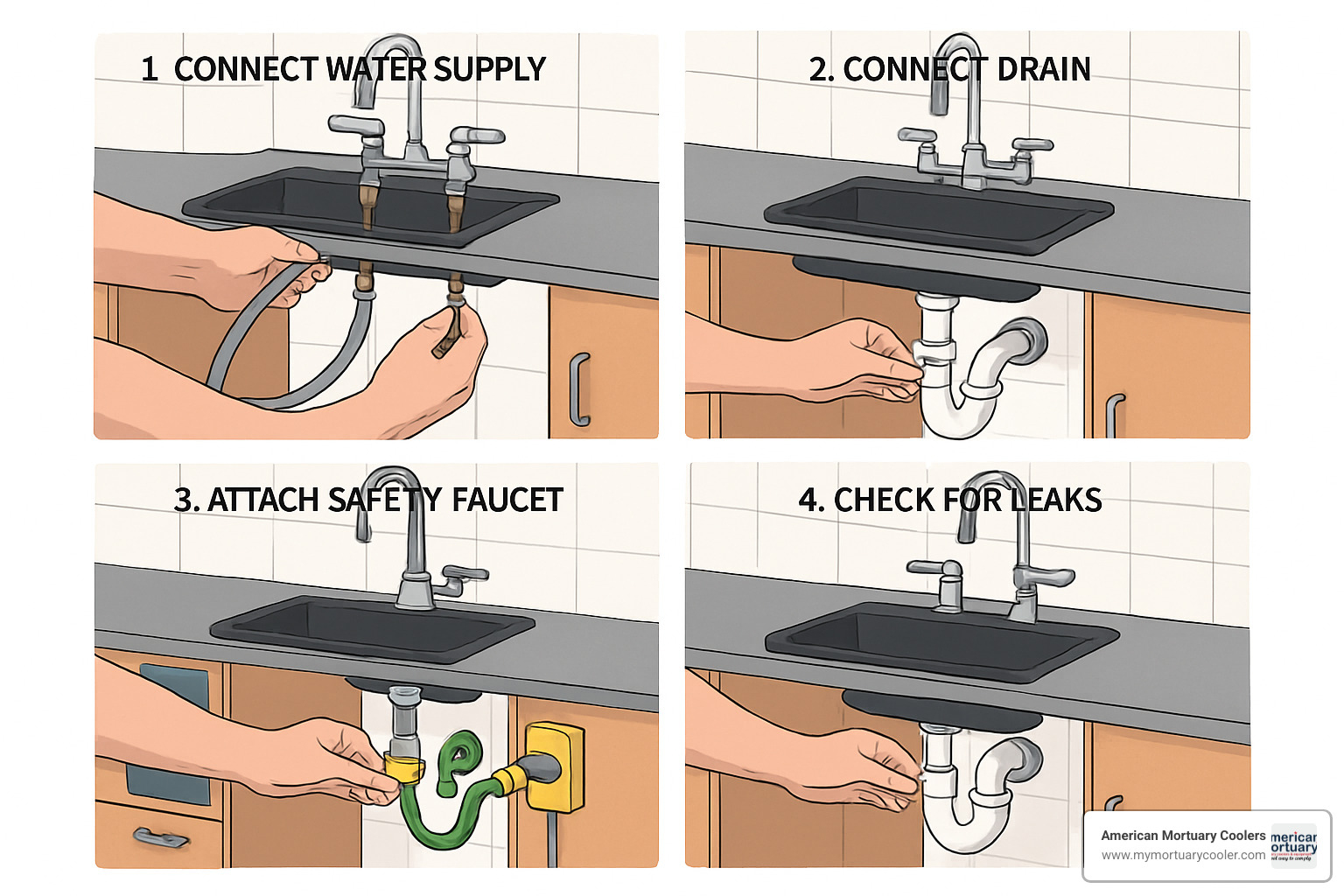
Installation Sequencing:
- Verify utility connections (water, drain, electrical)
- Level and secure cabinet to floor and/or wall
- Install countertop and sink
- Connect plumbing fixtures and test for leaks
- Install accessories (pegboards, shelving, etc.)
- Verify all safety features and compliance elements
Maintenance Protocols:
- Daily wipe-down with appropriate cleaners
- Weekly inspection of plumbing connections
- Monthly check of drawer and door operation
- Quarterly inspection of safety features
- Annual professional evaluation of structural integrity
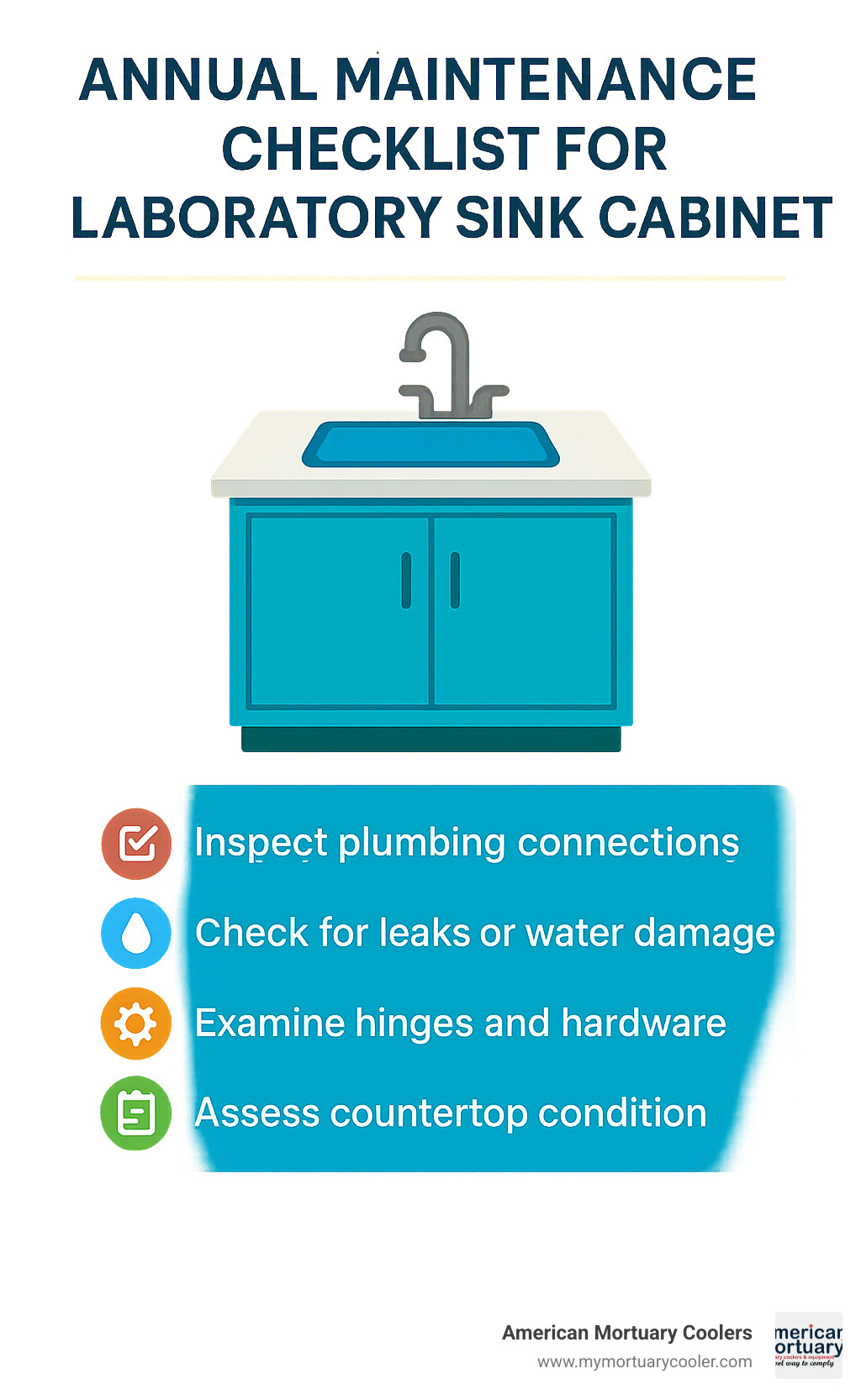
Through our experience serving laboratories across our service regions, we've found that thorough planning during the selection phase significantly reduces installation challenges and maintenance issues over the life of the laboratory sink cabinet.
Choosing the Right Laboratory Sink Cabinet for Your Industry
Different laboratory environments have unique requirements for their sink cabinets:
Biotech & Pharmaceutical:
- Emphasize chemical resistance and cleanability
- Often require 316 stainless steel for superior corrosion resistance
- May need integration with pure water systems
- Typically require documentation for GMP compliance
- Often feature foot-operated controls to minimize contamination
Educational Settings:
- Durability to withstand student use is paramount
- Cost-effectiveness for multiple installations
- Often configured for visibility and supervision
- May require ADA-compliant options
- Typically feature epoxy resin sinks for chemical resistance
Healthcare & Clinical:
- Infection control is a primary concern
- Seamless construction to prevent bacterial harborage
- Often include hands-free operation
- May require specific certifications for medical environments
- Typically feature stainless steel for easy sanitization
Industrial & Research:
- Heavy-duty construction for demanding environments
- Often require specialized waste handling systems
- May need integration with specialized gas or vacuum systems
- Typically feature larger, deeper sinks for equipment washing
- Often include reinforced bases for heavy load support
Forensic Laboratories:
- Chemical and biological resistance is essential
- Often require specialized ventilation
- May need integration with evidence processing workflows
- Typically feature improved security features
- Often include specialized drainage for biological materials
In our work with specialized laboratories across our service regions, we've found that understanding industry-specific requirements is crucial to selecting the appropriate laboratory sink cabinet configuration.
Laboratory Sink Cabinet Positioning Best Practices
Strategic positioning of laboratory sink cabinets within the laboratory layout significantly impacts workflow efficiency:
Work Triangle Concept: Borrowed from kitchen design, the laboratory work triangle connects:
- The sink area (cleaning and wet processes)
- Storage areas (supplies and equipment)
- Work surfaces (preparation and procedures)
Ideally, these three points should form a triangle with sides totaling no more than 20 feet for optimal efficiency.
Reagent Proximity Considerations:
- Position sink cabinets away from volatile or water-reactive chemicals
- Consider splash zones when locating sensitive equipment
- Provide buffer zones between incompatible activities
- Locate sinks near areas that generate the most waste
Shared Utilities Optimization:
- Group plumbing fixtures to minimize pipe runs
- Consider back-to-back sink installations for efficiency
- Plan for future expansion when routing utilities
- Include adequate access panels for maintenance
Best Practices:
- Position sink cabinets at the transition point between "clean" and "dirty" workflows
- Allow at least 4 feet of clearance in front of sink cabinets
- Consider left-to-right workflow patterns (for Western cultures)
- Provide adequate lighting above sink areas
- Include GFI electrical outlets nearby but positioned to avoid splash zones
In our experience designing laboratory spaces across our service regions, we've found that thoughtful positioning of laboratory sink cabinets can reduce unnecessary movement, minimize cross-contamination, and improve overall laboratory efficiency.
Trends & Innovations in Laboratory Sink Cabinets
The world of laboratory furniture is constantly evolving, and laboratory sink cabinets are no exception. I've been watching these trends develop over the years, and it's exciting to see how manufacturers are responding to the changing needs of modern labs.
A Splash of Color in the Lab
Gone are the days when laboratories were limited to sterile white cabinets. Today's laboratory sink cabinets come in a rainbow of color options that do more than just look pretty.
Many of our clients are using color strategically – designating different lab areas, improving visibility, and even reducing eye strain during those long research days. I recently visited a university lab where they used their school colors for their laboratory sink cabinets, creating both a functional workspace and a sense of institutional pride. It's amazing how something as simple as color can transform a clinical environment into a more engaging workspace.
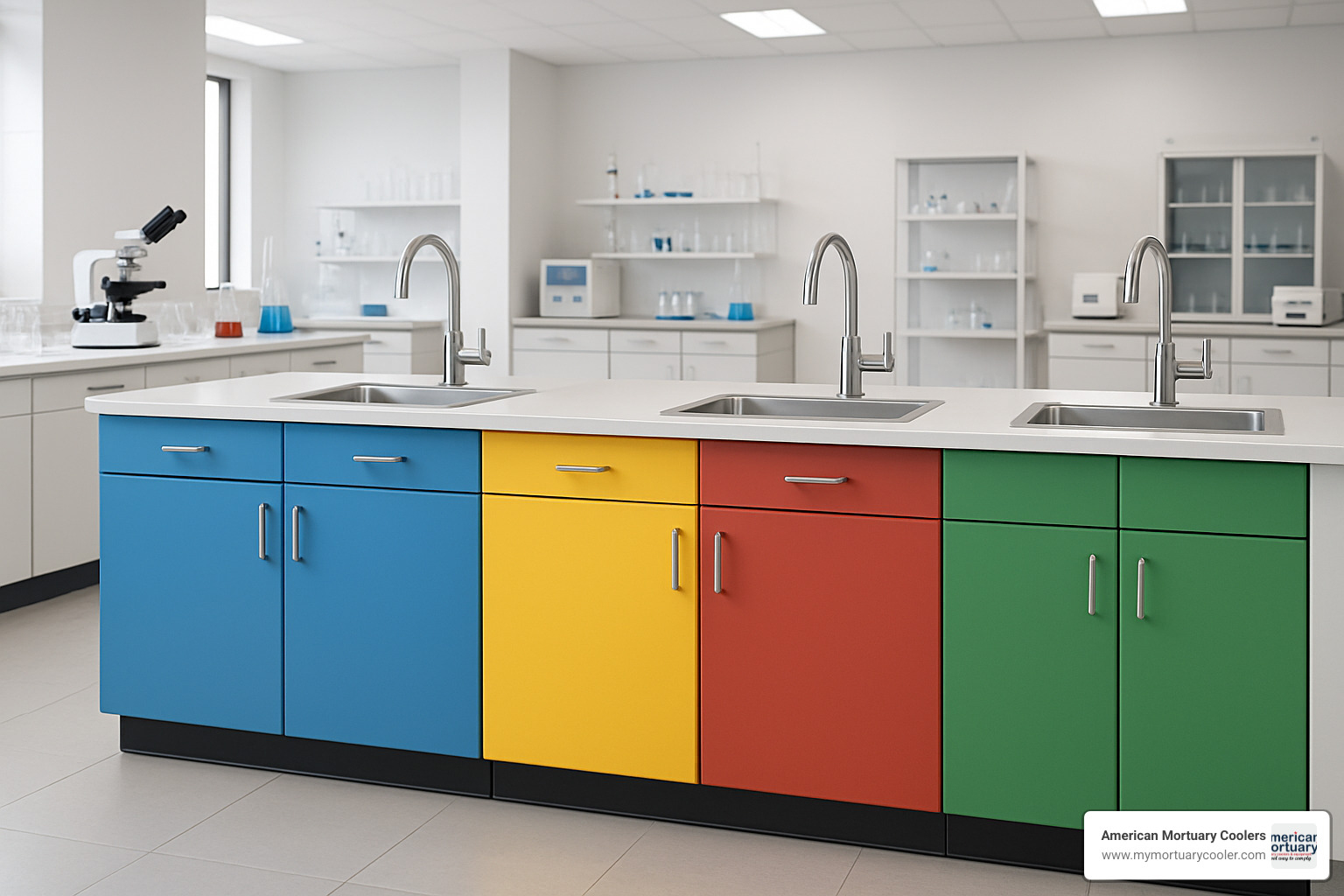
Flexibility for the Future
If there's one thing I've learned working with labs across the country, it's that scientific needs change – sometimes overnight. Modern laboratory sink cabinets now accept this reality with truly modular designs.
Today's cabinets feature field-convertible components that can be easily reconfigured as needs evolve. Shelving and drawers can be repositioned without tools, and some units even come with quick-connect plumbing and locking casters for complete mobility. This adaptability is a game-changer for labs that need to pivot their research focus or accommodate new equipment.
Fighting Germs at the Surface Level
The pandemic heightened our awareness of surface contamination, but laboratory professionals have always been concerned about cross-contamination. The latest laboratory sink cabinets now feature antimicrobial powder coatings embedded with silver ions that continuously fight bacterial and fungal growth.
What's impressive about these finishes is that they don't degrade over time – providing lasting protection particularly valuable in healthcare and food science settings. One of our clients in the medical research field reported a measurable decrease in contamination issues after upgrading to cabinets with these specialized finishes.
Smart Cabinets for Smart Labs
Remember when a sink was just a sink? Those days are firmly behind us. Today's laboratory sink cabinets are joining the Internet of Things with impressive smart features.
Touchless faucets with programmable flow rates not only improve hygiene but can be set to deliver precise water volumes for experimental protocols. Some high-end models include leak detection sensors that automatically shut off water flow and send alerts to building management systems. I even saw one system that uses QR codes on the cabinet facing to provide instant access to maintenance information and safety protocols – particularly helpful for training new staff.
Sustainability Meets Science
The push toward greener laboratories has influenced laboratory sink cabinet design in meaningful ways. Manufacturers are increasingly using recycled and recyclable materials, integrating water-conserving fixtures, and employing VOC-free finishes for better indoor air quality.
Some forward-thinking companies have adopted a cradle-to-cradle philosophy, designing cabinets with their eventual recycling in mind. It's refreshing to see scientific equipment that supports both research goals and environmental responsibility.
Built to Last a Lifetime
Perhaps the most significant trend I've noticed is the move toward lifetime guarantees. Premium laboratory sink cabinet manufacturers now offer lifetime warranties on cabinet frames, with extended coverage for moving parts and chemical resistance.
This confidence is backed by rigorous testing that exceeds SEFA 8 standards. For lab managers watching their budgets, these guarantees provide peace of mind that their investment will stand the test of time – even in the harshest laboratory environments.
I've seen beautiful examples of these innovations in action at the D55 Black Epoxy Sink 25'' x 15'' 10'' – Corner Drain, which pairs perfectly with these modern cabinet designs.
As someone who's helped outfit countless specialized environments over the years, I can tell you these innovations aren't just fancy add-ons anymore – they're rapidly becoming standard features, especially in newly constructed research facilities. The laboratory sink cabinet of today is smarter, more flexible, and built to adapt to whatever scientific challenges tomorrow may bring.
Frequently Asked Questions about Laboratory Sink Cabinets
What size laboratory sink cabinet do I need?
Choosing the right size laboratory sink cabinet feels a bit like Goldilocks - you want something that's just right for your space and needs.
First, take a good look at your available wall or island space. Grab a tape measure and account for any adjacent cabinets and the clearance you'll need for people to work comfortably. Lab work requires elbow room!
Think about what you'll actually be washing in your sink. Will you need to clean large beakers or just test tubes? Standard lab sinks typically range from 15" to 25" in length and 15" to 20" in width, but your specific needs might call for something different.
Don't forget about storage! If you're like most lab managers, you're always hunting for more storage space. If you need significant under-sink storage for cleaning supplies or other materials, wider cabinets in the 36"-48" range will be your friends.
In our experience working with labs across the country, a 36" wide cabinet hits the sweet spot for most facilities, providing enough sink space for daily tasks while still offering decent storage below. For specialized applications like washing lots of glassware, you might want to step up to a 48" cabinet with a larger sink.
As for height, standard laboratory sink cabinets come in either 35" (bench height) or 29-30" (desk height), with a standard depth of 22". Choose bench height for standing work and desk height if users will be seated or if you need ADA compliance.
How do I make sure my sink material is chemically compatible?
Chemical compatibility isn't just a nice-to-have feature - it's essential for safety and the longevity of your laboratory sink cabinet. Nobody wants a sink that dissolves when exposed to routine chemicals!
Start by creating a good old-fashioned inventory of all chemicals used in your lab, including those cleaning agents that might seem harmless but can actually be quite aggressive. Be thorough - sometimes it's the chemicals we use occasionally that cause the biggest problems.
Once you have your list, dive into the compatibility charts provided by manufacturers. These charts are like treasure maps for finding the right material. Here's what you'll generally find:
Epoxy resin sinks excel with most chemicals but might struggle with certain oxidizing agents. They're the workhorses of research labs for good reason.
Stainless steel offers good all-around resistance and looks professional, but beware of strong acids which can pit and damage the surface over time.
Polypropylene loves acids but hates heat - don't put anything too hot in these sinks.
Phenolic resin performs well across the board but can stain more easily than other options.
Concentration matters tremendously. A material might shrug off a 5% solution but fail dramatically with a concentrated version of the same chemical. And time matters too - brief exposure differs greatly from a spill left overnight.
When in doubt, request material samples from suppliers. There's nothing like testing your actual chemicals on potential materials before making your final decision. It's like dating before marriage - always a good idea!
Can I retrofit safety features onto an existing laboratory sink cabinet?
Yes, you absolutely can add safety features to your existing laboratory sink cabinet - some are weekend projects, while others might require professional help.
Let's start with the easy wins:
Adding a faucet-mounted eyewash unit is relatively simple and can be a literal lifesaver. These attach to standard laboratory faucets and provide immediate eye flushing capability when seconds count.
Chemical-resistant liners and drop-in trays can transform a standard cabinet into something more specialized. They're like adding a protective liner to your truck bed - simple but effective.
Foot pedal controls are another great retrofit that can reduce cross-contamination. They allow hands-free operation, which is particularly valuable when you're handling hazardous materials or cultures.
Spill containment trays that slide under existing cabinets can catch those inevitable drips and leaks before they become major problems. Think of them as insurance policies that actually pay off.
For more ambitious upgrades, you might need to call in reinforcements:
Converting a standard cabinet to full acid storage requires significant modifications to ensure proper containment and resistance. It's possible but complex.
Adding venting systems means cutting holes in walls and connecting to building exhaust systems - definitely not a DIY weekend project for most labs.
Emergency shower integration typically extends beyond just the cabinet itself and into building plumbing systems.
ADA compliance often requires complete replacement to meet specific height and knee clearance requirements - retrofitting existing cabinets for this can be more trouble than it's worth.
In our years of experience working with labs of all sizes, we've found that for significant safety upgrades, it's often more cost-effective to replace rather than retrofit. The labor costs for extensive modifications can quickly exceed the price of a new purpose-built laboratory sink cabinet with all the safety features already integrated.
When safety is on the line, sometimes starting fresh is the smartest move. Your lab team and your risk management department will thank you!
Conclusion
Choosing the right laboratory sink cabinet is a bit like finding a good partner—it needs to be reliable, match your specific needs, and stand by you through all kinds of challenges. Throughout this guide, we've walked through everything you need to make this important decision with confidence.
The cabinet you select will become the unsung hero of your lab, quietly supporting your team's work day after day. That's why material selection matters so much—the epoxy resin that shrugs off aggressive chemicals, the stainless steel that takes a beating and still looks professional, or the polypropylene that balances budget with performance. Your specific environment should drive this choice.
Safety features aren't just nice-to-haves; they're essential protections for your team. From acid storage compartments to eyewash stations, these elements create a foundation of security that lets researchers focus on their work rather than worrying about hazards.
Getting the size and configuration right makes all the difference in workflow efficiency. We've seen labs transformed when they move from poorly-sized cabinets to ones that match their actual needs—suddenly there's less bumping elbows, fewer spills, and smoother operations all around.
Even the best cabinet needs proper installation and regular TLC. Think of maintenance as an investment that pays dividends in longevity—a well-maintained cabinet can serve your lab faithfully for decades rather than years.
At American Mortuary Coolers, we understand specialized equipment needs. While our focus is creating custom cold-storage solutions for the funeral industry, we recognize the parallels between our work and laboratory environments. Both demand purpose-built equipment that performs reliably in specialized settings where failure isn't an option.
When you're ready to select your laboratory sink cabinet, take your time. Gather input from the people who'll use it daily. Consider not just today's needs but where your lab might be heading in the next five years. The right cabinet becomes almost invisible—it just works, day after day, supporting your team's important work without drama or disruption.
For your next laboratory design project, partner with specialists who understand scientific environments. While we focus on mortuary cooling solutions, we appreciate how every component contributes to creating safe, efficient specialized facilities where professionals can do their best work.
The best laboratory sink cabinet isn't necessarily the most expensive or feature-laden—it's the one that feels like it was designed specifically for your lab's unique needs and workflows. Choose wisely, and it will serve you well for many years to come.



